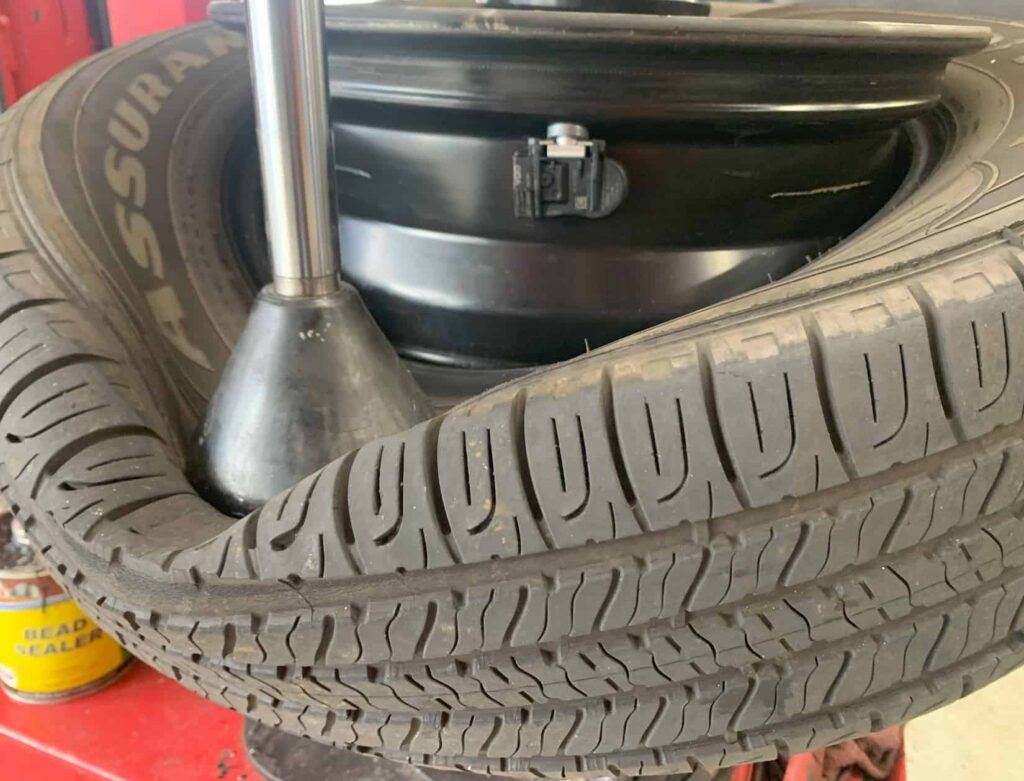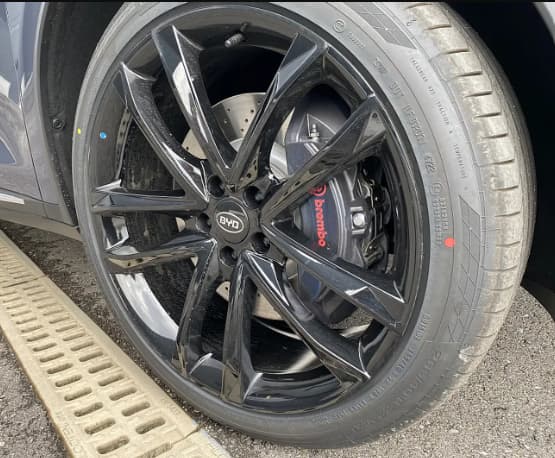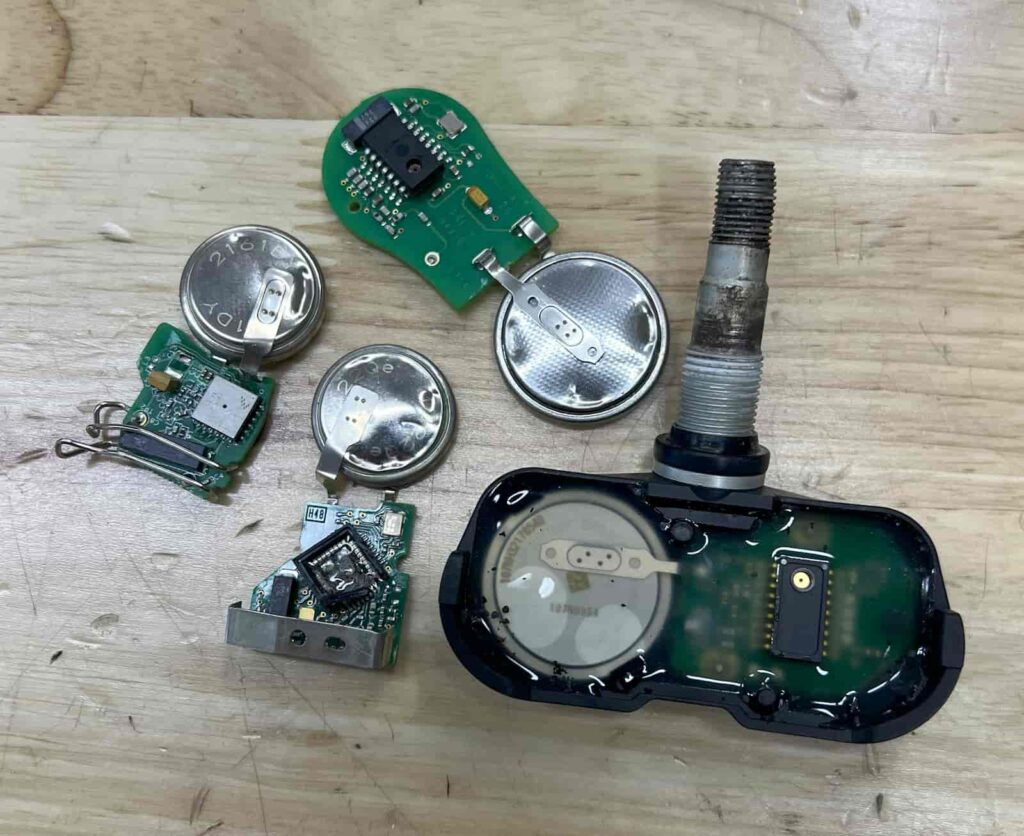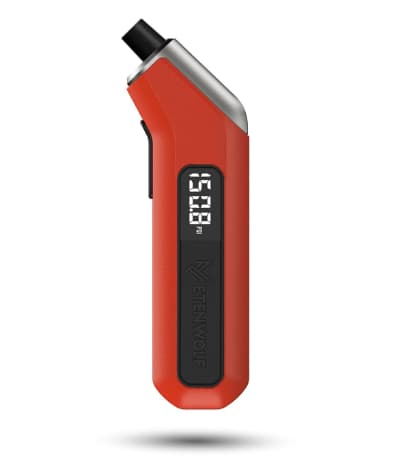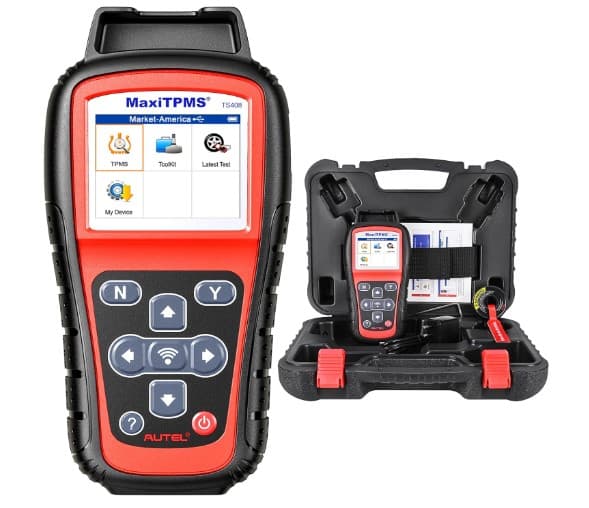The BYD Tang EV features a direct tyre pressure monitoring system. This setup includes a sensor in each tyre that constantly measures and transmits the real-time pressure readings to the driver’s display screen.
How Does the BYD Tang EV Tyre Pressure System Work?
BYD Tang EV Tyre Pressure Sensors
The BYD Tang EV’s tyres are each outfitted with a tyre pressure sensor encased in a plastic container. The container is mounted on the end of the tyre valve stem inside the tyre. Inside the plastic container is the sensor, consisting of a chip, battery, and radio transmitter. The chip, using battery power, gauges the tyre’s internal air pressure and temperature. This information is then sent via radio frequencies (either 315 MHz or 433 MHz) to the Tang EV’s TPMS receiver module.
BYD Tang EV TPMS Receiver Module
The BYD Tang EV’s TPMS receiver module collects air pressure data from the sensors located in each tyre. This data is subsequently transmitted to the vehicle’s central control unit (main computer), which is referred to as the Engine Control Unit (ECU) or Body Control Module (BCM).
BYD Tang EV ECU
Within the BYD Tang EV, the ECU assesses the tyre pressure information received, comparing it with BYD’s specified air pressure benchmarks. If the Engine Control Unit (ECU) identifies a tyre’s pressure as being 20% or more below the recommended 260-290 kPa (38-42 psi), it triggers a low tyre pressure warning on the information display screen.
How to Reset BYD Tang EV TPMS
Inflate all 4 BYD Tang EV tyres to 260 kPa (38psi) in the front tyres and 290 kPa (42 psi) in the rear tyres.
Select the INFO button on the top of the information display screen.
Select STATUS.
Select RESET next to “Tyre Pressure”.
Drive the BYD Tang EV for 10 minutes at speeds exceeding 30 Kph (19 mph).
How to Access the Tyre Pressure on the Instrument Cluster
Press the MENU button on the steering wheel.
Use the Right and Left arrow buttons on the steering wheel to navigate to the DRIVING INFORMATION bar.
Use the Right arrow button and select tyre Pressure by scrolling with the roller button on the steering wheel.
BYD Tang EV Tyre Pressure Alerts Explained
If the BYD Tang tyre pressure monitoring system detects a tyre with low or high air pressure or temperature the standard low tyre pressure symbol will turn on and a text prompt will appear with one of the following messages:
LOW TYRE PRESSURE
The display screen will alter the tyre pressure value to yellow, and the tyre pressure malfunction indicator light will activate.
ABNORMAL SIGNAL
The tyre pressure value shown on the monitor will switch to “Abnormal Signal,” and the tyre pressure fault warning light will blink before remaining illuminated.
SYSTEM FAILURE
A notification stating “Check the TPMS” will display, and the low tyre pressure indicator will flash before staying lit until the problem is addressed.
ESSENTIAL INFORMATION ON THE BYD TANG TPMS
Anytime any tyre is below 208 kPa or 30 Psi (80% of 260 kPa/38 Psi), the tyre pressure fault warning will turn on and the tyre pressure value on the display screen will change to yellow.
The BYD Tang EV tyre pressure alert will deactivate once the tyre pressure exceeds 95% of the standard tyre pressure.
If the BYD Tang EV is operational and a tyre experiences air loss at a rate exceeding BYD’s specified threshold, the TPMS will issue a “fast air leakage alarm” within 15 seconds, indicating which tyre is deflating on the tyre display screen.
The TPMS of the BYD Tang EV functions properly when the car is traveling at speeds above 30 kph.
Should the temperature of any tyre in the BYD Tang EV surpass 85 degrees Celsius (185 degree fahrenheit) for over 3 minutes, a High Temperature alert will be displayed. This alert changes the tyre pressure value on the display screen to yellow. It’s advised to stop the vehicle and allow the tyre to cool down before continuing to drive.
ghvcdfvg
HOW TO CANCEL TPMS ALARMS
Press the right roller on the steering wheel to cancel the tyre pressure alarm.
HOW TO CHECK TYRE PRESSURE FAULT INFORMATION
Rotate the right roller on the steering wheel to view the tyre pressure warning details for each tyre.
Why is the BYD Tang EV Tire Pressure Fault Warning Light Flashing?
If the tyre pressure indicator on the BYD Tang EV flashes, it indicates a malfunction in the tyre pressure monitoring system. Such issues often arise when one or more tyre pressure sensors fail to properly communicate with the car’s TPMS module or the Engine Control Unit (ECU) or Body Control Module (BCM). This could be due to various factors:
The battery in a tyre pressure sensor might be depleted or low, requiring replacement.
A sensor could have sustained damage during the installation of new tyres or wheels.
Interference from external radio frequencies emitted by other nearby vehicles or electronic devices might be impacting the sensors or the TPMS module.
The BYD Tang EV may have non-standard, unauthorized tyre pressure sensors or TPMS modules installed.
dfg
What Can Cause the BYD Tang EV Low Tyre Pressure Light to Turn On?
Tyre pressure that is excessively high or excessively low.
TPMS sensors are depleting in battery power or malfunctioning.
Complications with the TPMS receiver module, ECU/BCM, including software glitches.
Radio wave disturbances from adjacent vehicles or electronic gadgets.
A decrease in air temperature.
Overburdening the vehicle past its maximum weight capacity or exceeding towing limits.
Application of tyre chains on the EV’s tyres.
Excessively heavy window tinting on the vehicle.
Variability in road surface temperatures.
Harm to the TPMS sensors during tyre replacement or tyre services.
Neglecting the BYD Tang TPMS recalibration process post tyre inflation or maintenance.
Physical impairments to tyres or wheels, like punctures, deformations, or rim cracks.
Valve stems on the tyres being improperly installed or defective
Understanding Weather Induced Low Tyre Pressure Alerts in BYD Tang EV
The low tyre pressure alert in the BYD Tang EV is often activated due to weather-related changes. Tyre pressure typically varies by approximately 1 psi (6.8 kPa) for every 10°F (-12 celsius) shift in air temperature. For example, a 50°F decrease in temperature over the course of a month could result in tyre pressure dropping from 38 (290 kPa) Psi to 33 Psi (227 kPa) or lower, which could trigger the BYD Tang EV’s low tyre pressure indicator.
Tire Inflation
Underinflation
Operating the BYD Tang EV with underinflated tyres can result in several issues. It not only diminishes the vehicle’s battery range but also leads to accelerated wear on the outer edges of the tyre tread. Furthermore, underinflation compromises the vehicle’s handling, brake efficiency, and overall safety.
Overinflation
Operating the BYD Tang with overinflated tyres can lead to a harsher driving experience and cause the tyre tread to wear down predominantly in the center rather than evenly across its entire surface.
Cold Tyres
The tyre pressure in the BYD Tang EV should be inspected and adjusted when the tyres are cool, usually before the vehicle is driven or after letting it sit for at least 3 hours following its last journey.
Hot Tyres
Post-driving, the tyres of your BYD Tang heat up, causing the air pressure to increase by about 30-40 kPa (4-5 psi). Consequently, modifying the tyre pressure when the tyres are warm may lead to overinflation.
BYD TANG EV TIRE PRESSURE AND WHEEL SIZE
TYRE SIZE | Front Psi/kPa | Rear Psi/kPa |
255/50R20 | 38/260 | 42/290 |
265/40R22 | 38/260 | 42/290 |
BYD Tang Tire Pressure Sensor Batteries
Tyre pressure sensors are each powered by a single silver oxide battery. These batteries are non-rechargeable and non-replaceable. When a tyre pressure sensor battery runs out of power the tyre pressure sensor must be replaced. After replacing a tyre pressure sensor, the new sensor must be programmed to the BYD Tang ECU using a TPMS programming tool.
How Does Tyre Pressure Affect Battery Range?
Under-inflated tyres lead to increased rolling resistance, necessitating extra energy from the BYD Tang EV’s electric motor, thereby reducing the vehicle’s overall range. Keeping the tyres inflated to the recommended pressure (38psi/260 kPa) is crucial for maximizing the Tang EV’s battery range, as well as for stable driving performance and prolonging tyre lifespan. A reduction in tyre pressure by just 10% can cause a decrease of about 3% in the vehicle’s battery range.
How to Find a Leaking Tyre?
Inflate the leaking tyre to at least 275 kPa (40 Psi).
Mix water and liquid soap in a spray bottle.
Generously spray this soapy mixture over the entire tyre, ensuring to cover the bead area and the valve stem as well.
Look for the formation of bubbles and follow them to their origin to precisely locate the leak.
How to Find a Leaking Tyre?
If you have accurately adjusted the tyre pressure for all tyres and completed the TPMS reset procedure for your BYD Tang EV, yet the tyre pressure indicator continues to be illuminated or blinks before staying on, it’s advisable to employ a TPMS diagnostic tool to identify the issue. These tools are highly efficient in detecting problems with tyre pressure sensors. They can evaluate each sensor, providing detailed insights on aspects such as battery status, signal potency, tyre temperature, the sensor’s operating frequency in megahertz, and its precise position on the vehicle. In cases where the TPMS sensors show signs of low battery life or diminished signal strength, replacing these sensors is recommended.
BYD Tang EV Tire Tips
Rotate your tyres approximately every 10,000 km (6,000 miles).
Refrain from mixing tyre brands or sizes.
Change all four tyres at the same time.
After using BYD tyre sealant on a leak, quickly have the tyre and pressure sensor checked.
Equipping the BYD Tang EV with tyres or wheels of different sizes may affect the ABS and electronic stability control functions.
Please note that this blog post contains Amazon affiliate links. This means that if you make a purchase through one of these links, we at TPMSRESET.COM may earn a small commission at no extra cost to you. We only recommend products that we personally use and believe in. Thank you for supporting us.

